Advanced Computer Networks - Chapter 3
1/17
Earn XP
Description and Tags
SDN: Background and Motivation
Name | Mastery | Learn | Test | Matching | Spaced |
|---|
No study sessions yet.
18 Terms
(3P) Why are Network Requirements Evolving?
A number of trends are driving network providers and users to reevaluate traditional approaches to network architecture:
Demand is increasing
Cloud computing
Big data
Mobile traffic
Internet of Things (IoT)
Supply is increasing
Demand is raising, so is the capacity of network technology.
Traffic
Traffic patterns are changed and become more complex
(3P) Why are traffic patterns becoming more complex?
Client/server applications → Access multiple databases and servers
Network Convergence of voice, data, and video create unpredictable traffic patterns.
Unified communication involves heavy use of application.
Heavy use of mobile devices and BYOD policies.
Widespread use of public cloud.
Common practice of application and database server virtualization increased.
(3P) Why are Traditional Network Architectures Inadequate?
As QoS and QoE requirements imposed on the network are expanded as a result of the variety of applications, the traffic load must be handled in an increasingly sophisticated and agile fashion.
The traditional internet working approach is based on the TCP/IP protocol architecture.
Characteristics of this approach are:
Two-level end system addressing: Physical layer identifier and Logical layer identifier.
Routing based on destination: Use datagram approach
Distributed, autonomous control: When networks were mostly static and end systems mostly of fixed location.
(2P) What are Key Features of Traditional Networking?
TCP/IP Protocol Architecture: Built around the TCP and IP protocol, consist of 5 layers: physical, data link, network, transport, application.
Packet: A unit of data sent across a network.
Packet → group of bits (data + protocol control information)
Packet Switching: Large msg divided into small packets.
Datagram: Carries information sufficient for routing from S → D without logical connection.
Flow: Sequence of packets between S & D that are recognized by the network as related and are treated in a uniform fashion.
(5P) What are some Limitations of Traditional Network Architectures?
The Open Networking Foundation (ONF) cites four general limitations of traditional network architectures:
Static, complex architecture
Differing level of QoS, high and fluctuating traffic volume, security requirements, complex network technology.
Changing user requirements and traffic patterns.
Manual procedure to configure each vendor.
Inconsistent policies:
To configure a new policy → to make configuration and changes in thousands of devices.
Inability to scale:
Growing demand → Volume and Variety.
Due to complex static nature of network → difficult to add more switch and transmission capacity of multiple vendor.
Vendor dependence:
Need to deploy new capabilities and services
(2.5P) What are the requirements for SDN?
Adaptability: Networks must adjust and respond dynamically, based on application needs, business policy, and network conditions.
Automation: Policy changes must be automatically propagated so that manual work and errors can be reduced.
Maintainability: Introduction of new features and capabilities must be seamless with minimal disruption of operations.
Model Management: Network management software should manage the network as a whole model instead of changing each device one by one.
Mobility: Control functionality must accommodate mobility, including mobile user devices and virtual servers.
Integrated security: Network applications must integrate seamless security as a core service instead of as an add-on solution.
On-demand scaling: Implementations must have the ability to scale up or scale down the network and its services to support on-demand requests.
(1P) Modern Approach to Computing VS. Modern Approach to Networking (img)
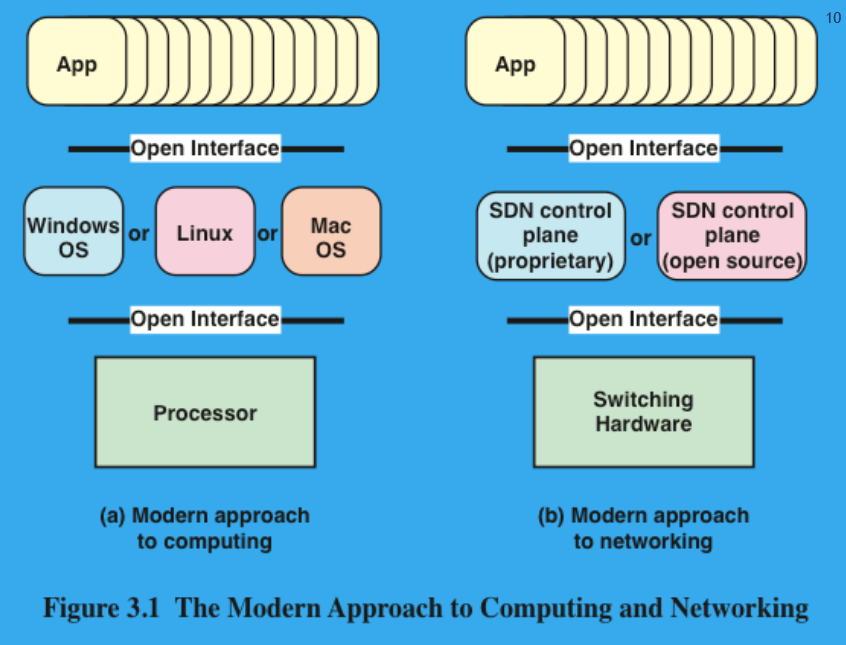
(1P) Traditional network architecture VS. SDN architecture
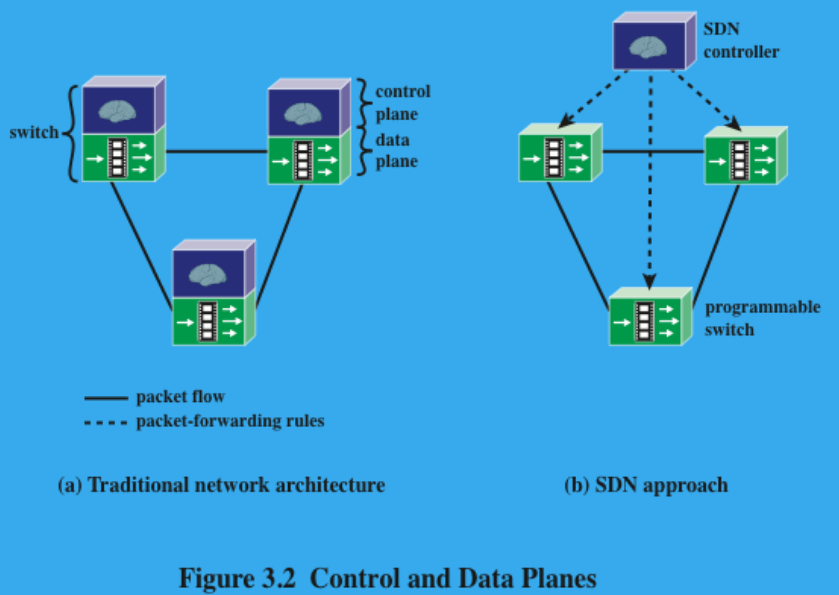
(3P) What is an Application Programming Interface (API)?
A language and message format used by an application program to communicate with the OS or other control programs such as DBMS or communication protocols.
APIs are implemented by writing function calls in the program, which provide the linkage to the required subroutine for execution.
An open or standardized API can ensure the portability of the application code and the vendor independence of the called service.
(1P) SDN Architecture (img)
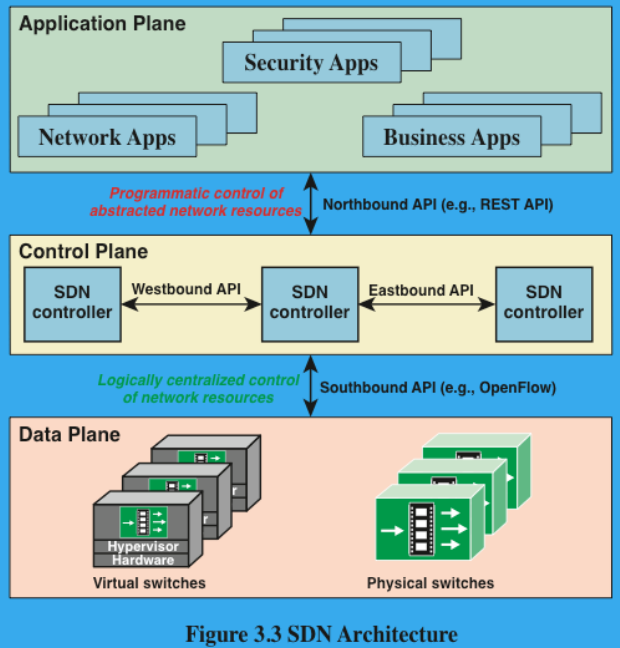
(3P) Mention some characteristics of Software-Defined Networking
The control plane is separated from the data plane.
The data plane devices become simple packet-forwarding devices.
The control plane is implemented in a centralized controller or set of coordinated centralized controllers.
The SDN controller has a centralized view of the network or networks under its control.
The controller is portable software that can run on commodity servers and is capable of programming the forwarding devices based on a centralized view of the network.
Open interfaces are defined between the devices in the control plane (controllers) and those in the data plane.
The network is programmable by applications running on top of the SDN controllers.
The SDN controllers present an abstract view of network resources to the applications.
(0P) SDN and NFV Standards Activities
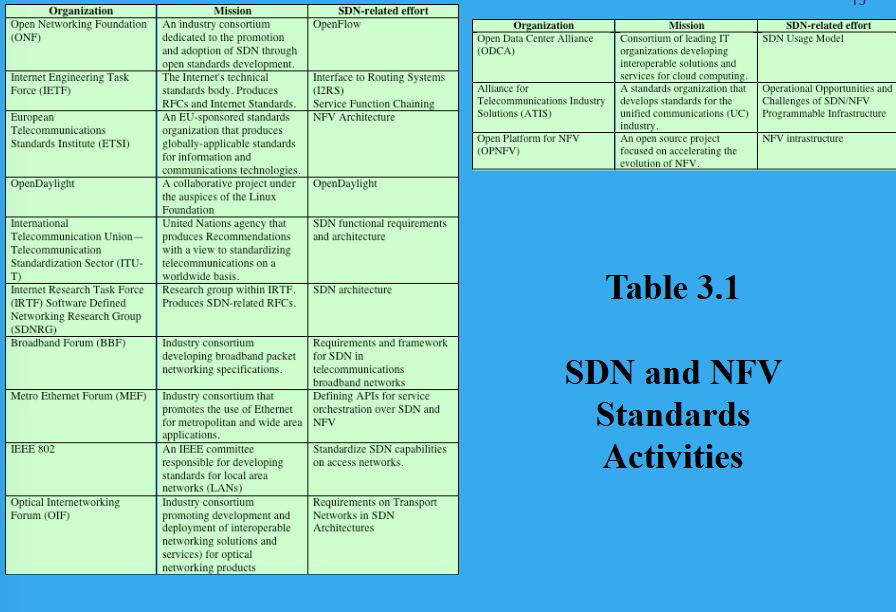
(3P) Define the following terms: Standard, Open Standard, Request For Comments (RFC), Standard Developing Organization (SDO), Consortium.
Standard: Documents that provide requirements, specifications, guidelines that can be used consistently to ensure that materials, products, processes, and services are fit for their purpose.
Open Standard: Developed on the basis of an open decision-making procedure available to all interested parties, is available for implementation to all on royalty-free basis.
Request For Comments (RFC): A document in the archival series that is the official channel for publications of Internet Society, including IETF and IRTF publication.
Standard Developing Organization (SDO): SDO, an official body that develops standards and coordinates the standard activities of a specific country, region, or the world.
Consortium:
→ A group of independent organizations joined by a common interest.
→ Consist of individual cooperation and trade groups concerned with a specific area of technology.
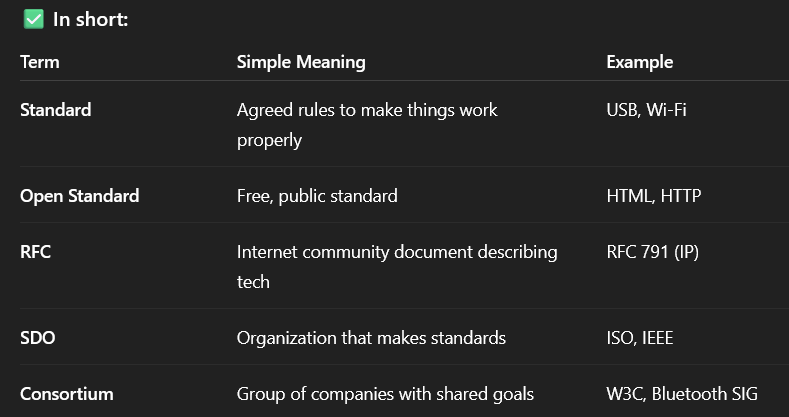
(2P) What are some Standards-Developing Organizations?
Internet Society (ISOC): The coordinating committee for Internet design, engineering, and management.
Internet Engineering Task Force (IETF): Interface to routing, service function chaining.
International Telecommunications Union — Telecommunication Standardization (ITU-T): Involved in SDN-related activities.
European Telecommunications Standards Institute (ETSI): Defining standards for NFV.
Industry Consortia: Consortium involved in SDN standardization is the Open Networking Foundation (ONF).
(2P) What is OpenDaylight?
An open source software activity under the support of the Linux Foundation.
Its member companies provide resources to develop an SDN controller for a wide range of applications.
Is more in the nature of an open development initiative rather than a consortium.
Also supports network programmability via southbound protocols, a bunch of programmable network services, a collection of northbound APIs, and a set of applications.
(2P) What is Open Platform for NFV (OPNFV)?
An open-source project dedicated to accelerating the adoption of standardized NFV elements.
Goal: Create a carrier-grade, open-source reference platform for NFV that ensures consistency, performance, and interoperability, while allowing industry peers to build it together.
To work with upstream projects to coordinate continuous integration and testing while filling development gaps. (OPNFV brings together different open-source projects (upstream), continuously tests and integrates them to make sure they work smoothly as one NFV platform, and creates any missing tools or code needed to fill the gaps.)
(2.5) What is OpenStack?
An open-source software project that aims to produce an open-source cloud OS.
Provides multi-tenant IaaS that is simple to implement, highly scalable, and supports both public and private cloud of any size.
SDN technology is expected to contribute to its networking part, and to make the cloud OS more efficient, flexible, and reliable.
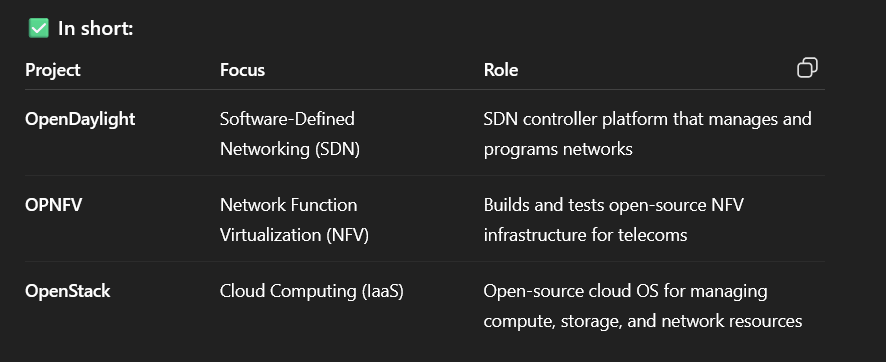
(1P) SUMMARY of open-source projects mentioned.
🧱 1. SDOs = rule makers
Standard Developing Organizations (SDOs) — like IETF, ITU-T, ETSI, or IEEE — are formal bodies that define standards, which are the official specifications that everyone must follow for technologies to be compatible.
They don’t usually build the software — they define how it should work.
Example:
IETF defines protocols like TCP/IP or HTTP.
ETSI defines standards for NFV (Network Function Virtualization).
💻 2. Open-source projects = real-world implementers
Projects like OpenDaylight, OPNFV, and OpenStack take those standards and turn them into working, testable software.
They act as reference implementations, proving that the standards can actually work in practice.